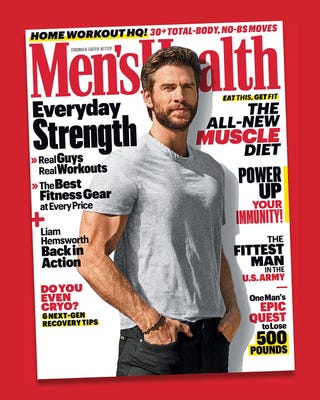Dr. Aaron Horschig, DPT, of Squat University, has shown us the best core stability exercises, stretches you should skip, and how to properly stretch. And now, he’s giving us tips for how to prevent knee pain while squatting—which is helpful both when you take on loaded variations of the exercise at the gym and bodyweight air squats at home.
According to Horschig, most issues with the squat come from knee pain, which is in turn due to either mobility and/or stability problems in the lower body. “Most of the time, when my lifters have pain in their knee when lifting, it’s classified as a biomechanical dysfunction,” he says. He compares the way the knee is moving through these exercises to a train being pulled off a track.
“We have to understand the complexity of our body and how our knee is directly linked to the way in which our ankle and hip is working,” he says.
He shares his top 4 tips for how to avoid knee pain that include:
Ankle Mobility
Dr. Horschig wants you to test your ankle mobility to start, so the first move is to take your shoes and socks off. Put your foot 5 inches away from a wall or rig. From there, drive your knee as far forward as you can, directly over your toe. Can you touch your knee to the wall? (Test both sides of your body.)
If not, he says you have a deficit in ankle mobility, which can cause an issue in the way your knee is tracking when you squat (possibly caving in or taking more force more quickly as you squat, overloading the joint causing knee pain.)
How to fix it: To improve your ankle mobility, do a box stretch. Put your flat foot up on the box or platform, push forward until you feel a good stretch in the back of your calf, holding for a few seconds and doing multiple reps.
Hip Mobility
“A lot of people have limitations in hip internal rotation,” says Horschig. He says he typically looks for a side-to-side imbalance as a cause of knee pain.
To test your inner hip mobility, take a seat, lift up one leg, and kick your foot out to the side. If one foot is not able to extend as far as the other, it may indicate a lack of internal hip rotation. “If I don’t have symmetrical hip rotation as I squat down, there’s gonna be uneven forces placed on the knee joint.”
How to fix it: Horschig recommends an assisted hip airplane. Standing on the single leg with mobility issues with the other leg elevated in the air (using a wall or weight rack to stabilize you), drop your pelvis toward the wall (think getting your belly button to point at the wall in front of you), feeling a deep stretch in the hip that is planted on the ground, holding for 5 seconds before doing it multiple times.
Knee Stability
To test this, Horschig advocates a touchdown squat. Grab a box and stand on it with one foot, planting your toes into the box. Driving the knee that is planted on the box forward, hinge your hip and bring the other foot to the floor, tapping the floor and coming back up. Dr. Horschig does this on a 12-inch box, but if it’s painful for you, start with a smaller box, anything from 2 to 4 inches.
How to fix it: Do 2 to 3 sets of 20 reps. “We need to rework your body’s endurance and coordination, and that takes a lot of reps,” he says.
Glute Coordination
“Glute activation is another thing people will see lots of issues with side-to-side that is another weak link,” says Dr. Horschig.
To do this, you’ll do a single leg bridge test. Raise up one leg into a bridge, holding for 5 to 10 seconds. As you raise, take note of the muscles you feel working to hold you up: quads, hamstrings, glutes, or back.
“What we’re looking for is an imbalance side-to-side. A lot of people who develop knee pain will say I don’t feel my glute as much,” he says. “I feel more quad, hamstring cramping. What that means is that you need to work on coordination control of your glutes.”
How to fix it: Double leg bridges. “Squeezing up, squeeze your glutes, drive your toes into the ground, and hold for 10 full seconds, then back down,” he says. Do this for 20 reps.

Source: Read Full Article
